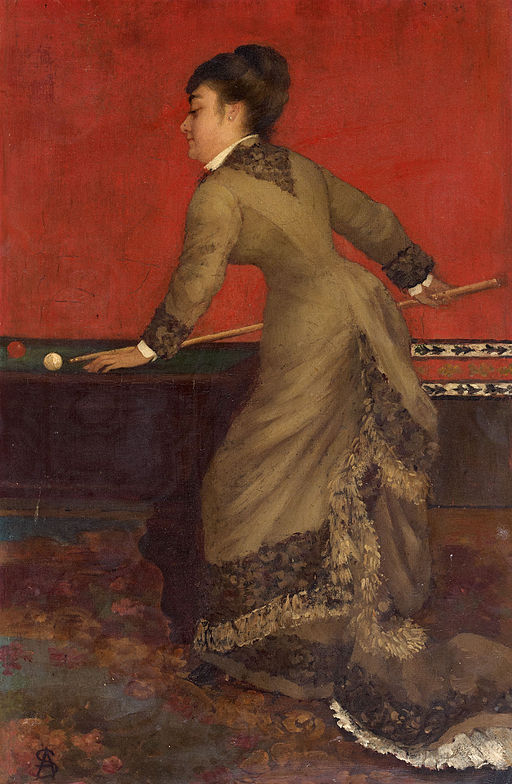
Historian sniffs: “It isn’t a picture. It is a painting. Oil on canvas, mounted on a parquet panel.”
Writer pouts: “You know what your problem is? You are too literal. What are paintings if not pictures telling a story. Who do you think this woman was?”
Historian: “As the title indicates, she was an anonymous Victorian lady. Although, I am not entirely sure ladies engaged in billiards.”
Writer: “Shows what you know. I read that in 1426 there was a Frenchwoman who could defeat all challengers.”
Historian: “But was she a lady? No respectable woman would play a game exposing so many, ahem, points of interest.”
Writer: “There you go again. Too literal. Women began participating in public competitions sometime after 1900. And this picture is dated 1906 or before.”
Historian: “Look at the painting. Such detail on the carpet. The subject is not playing in public.”
Writer: “I agree. Can you see what’s behind the picture?”
Historian: “Painting. “
Writer: “Whatever. Step back from facts and imagine who this woman might be. The details on her gown, the train. This is an evening entertainment. The lady is relaxed, confident. Has her eye on the ball, so to speak.”
Historian: “And respectable. Notice she does not bend over too far. Look how the artist designates the placement of her legs by the flow of her dress.”
Writer: “Exactly. Hmmm…who might she be playing? I think she must be in the library.”
Historian: “That would be the only correct place for such a large game table. I have seen them in conservatories, but this is an interior room.”
Writer: “I think she is playing with her brother. Perhaps he is home from school – perhaps a college in Oxford. Maybe he brought a few friends.”
Historian: “Really! Next you’ll suggest she’s playing for money.”
Writer: “No. She is playing to prove a point. Billiards is a game of analytical skill and manual dexterity – abilities open to both sexes. Win or lose, she has the right to play.”
Historian: “You may be on to something. That could be what inspired the artist.”
Writer: “Or not. That’s the miracle of art. There are technical points of time, place, and skill. But, if one looks deeper, there is always a story.
HISTORIAN & WRITER LINK ARMS AS THEY WALK OFF THE PAGE

Sandra Wagner-Wright holds the doctoral degree in history and taught women’s and global history at the University of Hawai`i. Sandra travels for her research, most recently to Salem, Massachusetts, the setting of her new Salem Stories series. She also enjoys traveling for new experiences. Recent trips include Antarctica and a river cruise on the Rhine from Amsterdam to Basel.
Sandra particularly likes writing about strong women who make a difference. She lives in Hilo, Hawai`i with her family and writes a blog relating to history, travel, and the idiosyncrasies of life.

